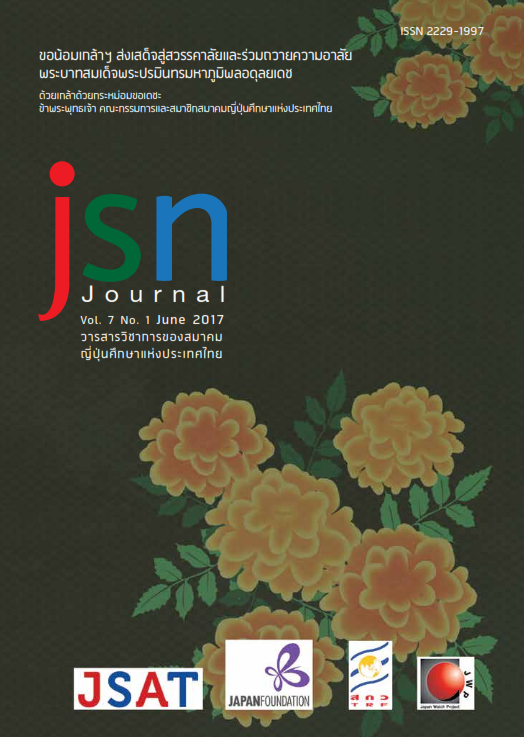A Study of Using Kanji Mapping in Kanji Instruction for Pre-Intermediate Thai Learners of Japanese
Main Article Content
Abstract
This article report on the results of an experimental study using Kanji Mapping in Kanji instruction for 8 pre-intermediate Thai learners of Japanese. Kanji Mapping has been applied from a Mind Map which was developed by Tony Buzan, combined with Bushu (部首), Kanji’s radical representing meaning as a linkage to other Kanji and vocabularies in order to support Kanji learning. The purposes of this research are 1) to study a change on using Kanji Mapping for learners. 2) to survey an attitude of learners toward using Kanji Mapping. For research methodologies, the researcher assigned the learners to write Kanji Mapping 4 times to collect the results and analyze comparatively to find out the average and interpret result descriptively. The results are 1) In terms of changes in learning, Kanji Mapping can help the learners understand the basic meanings of Kanji more easily. The learners have gained self-confidence in learning new vocabulary imaginatively in wider contexts outside the classroom. It is found that this technique is also suitable for vocabulary review. 2) In terms of learners’ attitudes, the learners have realized the benefits of Kanji Mapping. In their opinions, it is an easy and useful technique. However, it fails to make learners enjoy learning Kanji. The problem found in this research was lacking of basic knowledge in Kanji and vocabularies in the pre-intermediate learners, so the learners could not make linkages of vocabularies as much as they were expected, and there were miswriting found as well. The obstacles of this research were lacking of time to do activities and insufficient size of population, then the tendency result cannot be concluded.
Article Details
ข้อความและข้อคิดเห็นต่างๆ ในบทความเป็นของผู้เขียนบทความนั้นๆ ไม่ใช่ความเห็นของกองบรรณาธิการหรือของวารสาร jsn Journal
References
โทนี บูซาน, แบรี บูซาน. (2552). คัมภีร์ Mind MapⓇ [The mind mapⓇ book].(ธัญญา ผลอนันต์, นภดล จำปา, ผู้แปล). กรุงเทพฯ. สำนักพิมพ์ขวัญข้าว.
ธราเทพ แสงทับทิม. (2557). เพิ่มพลังการจดและการจำของสมอง magic mind map.(พิมพ์ครั้งที่ 2). นนทบุรี: พราวโพเอท.
Busan, T. & Busan, B. (2003). The mind mapⓇ book. Great Britain: BBC worldwide limited.
Busan, T. (2002). How to Mind Map. Great Britain: Thorsons Publishers.
飯島有美子 (2012). 「マインドマップによるノートティキングの試し「日本事情」 クラスにおけるドキュメンタリ映像視聴の記録として」『関西国際大学人間科学部 研究紀 要13号, 187-194.
(2015). 「語彙マップを掲載した漢字教材を使用しての漢字授業語彙習得 から作文へ」『JSL漢字学習研究会誌』 7号, 19-28.
インゲボルグ・ヴェルプランク (2012). 「漢字・語彙理解を助けるストラテジー成功例 と失敗例の考察」 『CEFP B1 言語活動・能力を考えるプロジェクト 2012 年度活動報告書』 40-49.
片岡久明 (2009).「マインドマップを効果的に活用する学習方法の提案」 『日本教育 情報学会年会論文集』 第 25 巻, 364-365.
関麻由美・池田幸弘 (2014). 「マインドマップを用いた漢字学習法質的分析の試み」『JSL漢字学習研究会誌』 6号, 80-86.
高橋文徳 (2012). 「マインドマップが学習効果を高める要因の検証」 『尚絅学園研究紀要.B,自然科学編』 第6 号, 11-18.
田中ソノ (2004). 「マインドマップ」 による指導法聴解授業の実践記録」 『日本 語教育方法研究会誌』 11号, 12-13.
徳弘康代 (2003). 「漢字認知処理からみた効果的漢字習得法の研究相互結合型概念地図作成の試み」 『早稲田大学日本語教育研究』 2号, 151-176.
山本利一・大関拓也・五百井俊宏 (2009). 「マインドマップを活用した生徒の思考整理を支援する指導過程の提案」『教育情報研究』 第 24 巻 第 3 号, 23-29.
和田一菜 (2010). 「マインドマップを用いたライティング活動の試み目標言語で考え、構成する力の育成を目指して」 『長崎大学留学センター紀要』 18号, 81-96.


